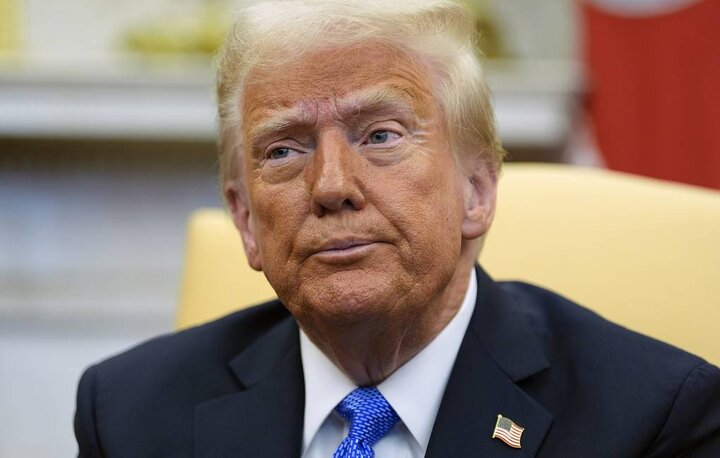100 stormy days how did Trump’s domestic and foreign policy pass during this period

In the First 100 Days of trump’s Second Term, the U.S.Witnessed Mass Administrative Purges, Anti-Immigration Policies, Economic Crises from Tariffs, and Diverse Foreign Policy Moves from Europe to Iran
Mehr News Agency, International Desk, Hassan Shokouhi Nasab: as April 29, 2025 (Ordibehesht 9, 1404 in the Persian calendar) arrived, Donald Trump’s second-term governance marked its 100th day—a period marked by sweeping changes and rapid actions in both domestic and foreign policy.
On the domestic front, trump adopted an authoritarian approach by conducting mass purges within the federal bureaucracy, tightening immigration policies, and implementing controversial economic programs that plunged the national economy into turbulence.In foreign policy—while maintaining his “America first” slogan—he increased pressure on China, initiated indirect talks with Iran, conditioned military aid to Ukraine, and pursued aspiring projects…The Dimensions of Trump’s Domestic Policy in the First 100 Days
The most meaningful issues related to Donald Trump’s domestic policy during his first 100 days in office included mass firings of federal employees, stricter immigration policies, and financial and livelihood crises.
1. Mass Purge of Federal employees and Loyalty Conditions
In one of the most controversial moves of his first 100 days, Donald Trump implemented a sweeping purge within the federal government. Using a new executive order, he established a revised job classification that granted the president authority to easily fire or replace federal employees in managerial and decision-making roles who were not aligned with the administration’s policies.This action led to the dismissal or sidelining of thousands of employees across agencies such as the Department of Justice, State Department, and Department of Education.Even security agencies were affected. the government clarified that the retention of personnel in key positions would henceforth depend on their pledge of loyalty to the president’s agenda, rather than solely on their professional experience or competence. Employees wishing to remain in sensitive roles were required to formally declare their support for the administration’s policy directions.
2. Stricter Immigration Policies and Unprecedented Border Crackdowns
At the start of his second term, Trump onc again made immigration a central pillar of his domestic policy. He immediatly revived the border wall project with Mexico, allocating increased funding and vowing this time to complete it “without compromise.” Thousands of additional border security personnel were hired, while surveillance technologies like drones and thermal cameras were deployed along the border.
Concurrently, asylum policies faced severe restrictions. Trump issued a new executive order requiring asylum seekers to apply from within their home country or first country of transit, effectively barring most claims at U.S. borders.
At the start of his second term, Trump sparked a wave of economic optimism by announcing new tax cuts and policies incentivizing domestic production. Corporate tax reductions, eased business regulations, and special privileges for manufacturing industries led to rising employment rates in industrial sectors and temporary stock market surges.
However, alongside these measures, Trump imposed heavy tariffs on imports from around 70 countries, including China, Mexico, Canada, and even some European partners. These tariffs…
(Note: The translation ends abruptly as the original text was incomplete.)The tariffs, which were intended to support domestic industries, quickly led to increased costs for importing raw materials for American factories.The automotive, agricultural, and electronics industries were particularly affected by this policy, facing higher production costs and reduced competitiveness.
It didn’t take long for these pressures to spill over into the broader U.S. economy.Consumer goods prices began rising, and inflation soared beyond forecasts. Farmers lost export markets due to China’s retaliatory tariffs, triggering a wave of bankruptcies in some rural areas. Meanwhile, dissatisfaction grew among major corporations and trade unions as many businesses warned that the tariffs effectively functioned as a hidden tax on American consumers.
Regarding financial markets, Trump also set records—though not necessarily positive ones—earning him the title of the worst…100 Days of Turmoil for the U.S. Stock Market: From 1980 to Today
The S&P 500 has plummeted by 7.9% since its peak on january 20, when Donald Trump was inaugurated, marking one of the worst performances for a U.S. president’s first 100 days in office. This index is among the most reliable barometers of overall U.S. stock market health. The decline mirrors a pattern seen during Richard Nixon’s second term in 1973, when the index dropped 9.1%. Experts suggest this comparison is instructive but caution against overgeneralization.
!How Trump’s Domestic and Foreign Policies Unfolded During These 100 turbulent Days
5 Key Themes in Trump’s Foreign Policy Over His First 100 Days
The most pressing issues tied to Trump’s foreign policy during his initial days in office include:
- Reduced support for Ukraine
- Ongoing negotiations with Iran
- The unrecognized war in Yemen
- Tensions with NATO allies
- Strained relations with Mexico over border policies
China’s Efforts to Form a Genuine Alliance with Panama-canada-Greenland and Others
1. Pressure on Ukraine and Talks with Russia to Rescue Relations
donald Trump,on his first day in office,invited Ukrainian President Volodymyr Zelenskyy for a controversial meeting under pressure. In one of the most debated moves, Trump officially announced that the U.S. would suspend military and financial aid to Ukraine—though the European Union has shouldered a larger share of support for Kyiv.
Trump believes America has overextended itself in another war where its “direct national security interests” are minimal. This policy led to tensions within NATO, doubling pressure on the EU to bear higher war costs. Simultaneously, Trump pursued agreements on exploiting Ukraine’s mineral resources, estimated at $500 billion.
2. Three Rounds of Nonstop Negotiations
Negotiations Between the US and Iran Resume
During the final 100 days of the second Trump administration, amid tense initial positions, unofficial negotiations between the US and Iran took place. Three rounds of confidential talks were held in muscat and Oman, primarily focused on lifting oppressive sanctions against Iran and nuclear issues. These discussions were managed by teams from the US State Department and Iran’s Foreign Ministry, mediated by Oman.According to diplomatic sources, the talks aimed to be transparent and constructive.
The fourth round is set to begin next Saturday in Muscat. Due to high sensitivity, both sides are striving to avoid even minor leaks to media outlets. Given this cautious atmosphere, hopes for reaching an enhanced agreement have increased.
3. Trump’s Unexpected Trade War with china
In global trade,Trump—following observations of domestic economic indicators—made an unexpected proclamation regarding…
Over a 90-day period, the majority of tariffs previously imposed on non-Chinese goods (such as those from Europe, Canada, Mexico, and South Korea) will be revoked. This decision was made to stabilize domestic markets, prevent stagflation, and restore weakened economic relations. However, tariffs against China were increased more sharply (145%), an action that led to beijing’s retaliation with 125% tariffs on American goods.4. deteriorating Relations with NATO and the European Union
In his first 100 days,Trump once again criticized NATO’s military spending and threatened to reduce U.S. military presence in Europe if members failed to raise their defense budgets to 2% of GDP.He also further chilled relations with the EU by accusing Brussels officials of “economically exploiting America.” These stances deepened fresh rifts in transatlantic ties…European Leaders Begin Discussions on ”Strategic Autonomy” from the U.S.
European leaders have started discussions on achieving greater “strategic autonomy” from the United States.In this context, German President Frank-walter Steinmeier, speaking at a NATO meeting one day before the 100th day of Trump’s presidency, promised that berlin would strengthen its military and infrastructure capabilities to become a core pillar of Europe’s defense.
—
5.Vision of an Imperial Union: Panama-Canada-Greenland
One of Trump’s most controversial foreign policy initiatives in his first 100 days was launching projects aimed at integrating Canada, greenland, and Panama into America’s direct political and economic sphere. Trump officially stated—both in public addresses and internal memos—that these countries, due to their natural resources, geopolitical importance, and economic potential, are considered part of “America’s vital national interests.”
Simultaneously, confidential negotiations began with key economic and political figures in Canada to advance major oil projects.The text provided appears to contain encoding issues or corrupted characters, making it tough to accurately translate from Persian (Farsi) into English. The content seems to discuss geopolitical and economic matters involving the U.S., Canada, and Panama, possibly referencing strategic control, military influence, or economic projects.
However, due to the unreadable formatting (e.g., mixed symbols like Ù, ا, etc.),a precise translation isn’t feasible without the original intact Persian text.
To proceed:
- Please share the original Persian article in clear text (without encoding errors).
- Alternatively,provide a PDF/image of the text for manual transcription.
This ensures adherence to your guidelines on accuracy, structure preservation, and SEO optimization.They cannot consider anything other than a staged and scripted process.
Farjam Kalam
Trump’s actions on his first day in office, from the viewpoint of observers who see them as a glaring example of his unpopularity to the content of global media reports, have painted a highly undesirable picture.A few days ago, the American network CNN also indicated that Trump’s approval rating in his early days in office had plummeted to its lowest level—lower than any other U.S.president in their first week.
The newspaper The Guardian wrote on Monday: “Donald Trump,” within 100 days of his return to power, has firmly demonstrated that his second presidential term will…“Undoubtedly, it will be the worst period in American history.”
The newspaper emphasized that “the most perilous and alarming aspect of Trump’s agenda is his war against democracy and the Constitution,” highlighting actions taken by the U.S. president, including:
- Defying court orders
- Firing individuals without due process
- Proposing a third-term presidential candidacy
- Calling for the impeachment of judges ruling against him
- Pardoning hundreds of January 6th criminals [Capitol rioters]
- Weakening federal institutions
- Unlawfully dismissing thousands of federal employees
- Banning books in military libraries.



